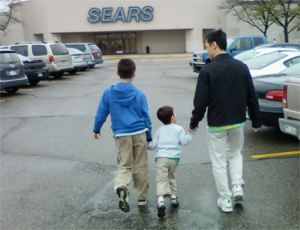
Resources
What Is Self-Regulation?
Self-regulation is one of those odd things that most people are unable to define, but EVERYONE notices when it’s missing.
A person may be unable to self-regulate if:
- He prevents himself from falling asleep by slapping his own face or thrashing his limbs around even when he can barely keep his eyes open.
- She giggles to herself, which escalates into uncontrollable laughter or crying for a long period of time in an inappropriate situation, and cannot stop herself.
- He doesn't understand the difference between feeling hungry or full. He doesn't recognize the feeling of needing to use the bathroom until it’s almost too late.Mild stressors, such as temporarily misplacing a toy, send her into a panic.
So...what is it?
In his book The Developing Mind , Daniel Siegel defines self-regulation as “the way the mind organizes its own functioning...fundamentally related to the modulation of emotion...Emotion regulation is initially developed from within interpersonal experiences in a process that establishes self-organizational abilities.”
, Daniel Siegel defines self-regulation as “the way the mind organizes its own functioning...fundamentally related to the modulation of emotion...Emotion regulation is initially developed from within interpersonal experiences in a process that establishes self-organizational abilities.”
See? Clear as mud.
I’ll break it down for you:
Self-regulation is a cognitive process that begins in infancy.
Every time a caregiver responds appropriately to an infant’s cries, vocalizations, gestures, eye contact or other nonverbal communication, the infant is learning cause and effect. The infant learns to modify his or her own behavior so that basic needs are met.Self-regulation is an “executive function” of the human brain.
Individuals with neurological conditions such as ADHD, autism, seizure disorders, traumatic brain injury, and even those undiagnosable folks who aren’t quite neurotypical may find difficulty with self-regulation.Self-regulation is intertwined with emotional development.
We all feel satisfaction when our needs are met, and some level of distress when we are not fulfilled. Most people learn how to soothe themselves during times of distress. Most people also learn when it is appropriate to express or suppress different types of emotion.Self-regulation is intertwined with social development.
This means that every time a person interacts with another person, new social cues are absorbed, and behavior subtly adapts to new people and situations. The psychologist Lev Vygotsky, who was one of the first researchers to study self-regulation, wrote, “Through others we become ourselves.”Regulation-Dysregulation-Regulation
What can you do if someone whom you love is in a constant state of dysregulation?
Remember: this is a learned behavior, and no one learns it alone.
The pattern for learning self-regulation is always the same, and always has been for the history of humanity. We start in a state of equilibrium with another person: some type of interaction, movement or a quiet state. Then a challenge is introduced, and we become imbalanced. Finally, we find our way back to a state of regulation.
Here’s a beginner’s list of ways to teach self-regulation:
1. Play a game that involves starting out slow, going faster and faster, then slowing down again, such as patty-cake or singing nursery rhymes. Fingerplays like “The Itsy Bitsy Spider” also work well at changing speeds.
2. If your child will walk with you, make it a game for the child to match your pace. Give the child plenty of time to adjust to your speed. Start off walking slowly, then walk quickly, jog and walk slowly again. My husband just reminded me that we used to surprise our son by stopping suddenly and waiting for him to notice - our son thought this was hilarious.
3. Using chalk outdoors or masking tape indoors, write instructions on the ground for different types of movement to do with your child. For example, write “Walk,” then 8-10 feet later write “Hop,” then “Crawl,” then “Run,” then “Skip,” and finally “Walk” again. Even better if there’s a happy surprise at the end of the walk: I prefer to end this game with the instruction, “Kiss.”
4. Many traditional kids’ games are based on self-regulation, such as “Simon Says,” “Red Rover,” “Red Light, Green Light” and “Mother May I?”
5. Board games or simple collaborative games also provide an opportunity self-regulation, by requiring turn-taking and careful observation of other players’ movements.
6. Community-based outings are another great way to teach self-regulation. This is one of the reason my family loves to go to amusement parks: a certain type of behavior is expected while waiting in line, then we get to experience the excitement of a ride together, and we calm ourselves as we choose another ride and go wait in line for it.
7. Taking a break from a preferred activity and doing something different, such as Brain Gym or Bal-A-Vis-X exercises, then returning to the preferred activity, is excellent practice for self-regulation.
8. The book Relationship Development Intervention with Young Children by Steven Gutstein and Rachelle Sheely has a chapter full of self-regulation exercises for children with special needs.
When my first son was little, the only way he could fall asleep and remain asleep was to press his ear right up to my heartbeat. Unable to self-soothe, he depended on the external regulation of my heartbeat to calm himself. I often woke up with the shape of his tiny ear perfectly imprinted on my chest. Eventually, as his receptive language progressed, I was able to teach him how to fall asleep on his own by describing the feeling of relaxing muscles in the simplest language possible. Through repeated interaction over many years, he learned how to slow himself down enough to feel tired and to recognize the feeling of drowsiness.
But his ear is still stamped upon my heart, a memory of the lesson he taught me about our shared humanity.



